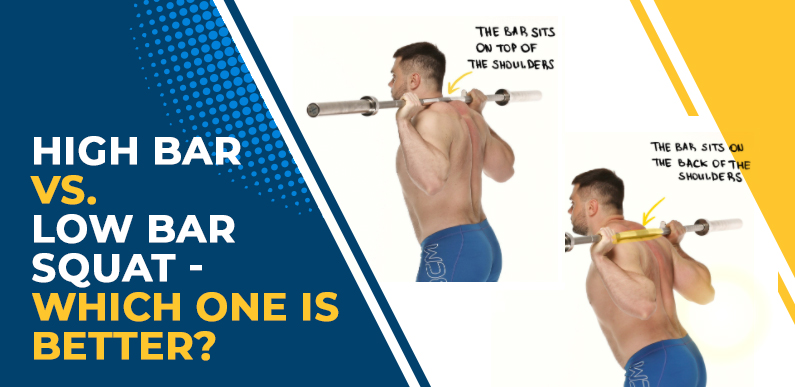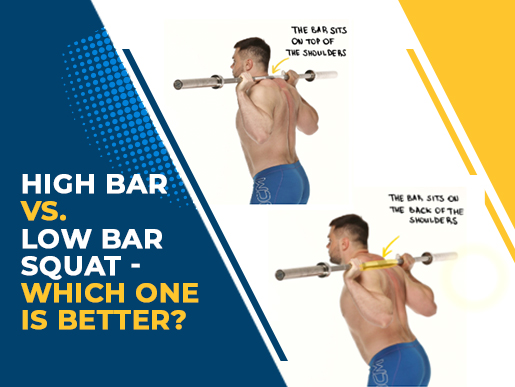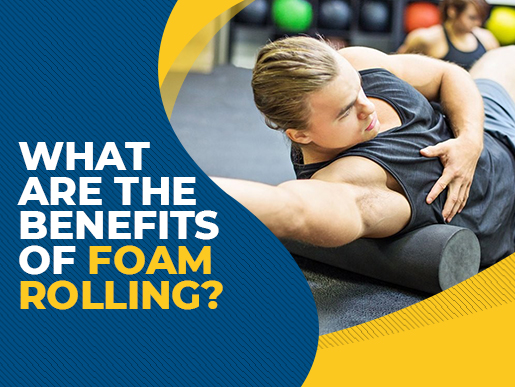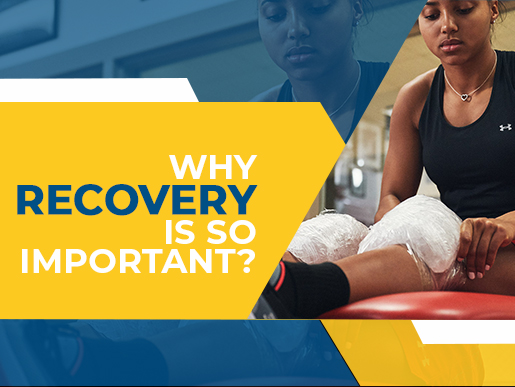When it comes to the almighty back squat, you will usually hear about two variations: the high bar vs. low bar squat. Which one should you choose? Is one better than the other? Let’s answer both of these questions!


High Bar Squat Characteristics
The high bar squat is defined by resting the bar on your back, on a muscular shelf created by your upper trapezius muscles. This would be the “standard” variation of the back squat that you will see in most commercial gyms.
Since the bar is carried relatively higher up on the back, this will create a relatively vertical torso and forward knee translation. This is necessary in order to keep the barbell centered over the middle of the foot throughout the entire rep.
Regardless of what squat variation you’re using, the barbell should ALWAYS be centered over the middle of the foot from the side view. This will maximize the mechanical efficiency of the lift and ensure you’re not doing more work than you need to!
Low Bar Squat Characteristics
In the low bar squat, the bar is carried a little lower on the back, on a muscular shelf created by the rear deltoids. This version is more popular in the powerlifting and strength-oriented communities. You won’t see it quite so frequently in your average commercial gym.
Since the bar is carried a little lower, it will create more forward torso lean and less forward knee translation. This, again, is what’s required in order to keep the barbell centered over the middle of the foot.
This increased torso lean creates a mechanical advantage for the posterior chain and allows strength athletes to squeak out a few more pounds on the platform.
High Bar vs. Low Bar…Which is Better?
Now that you know the basic differences between the high bar vs. low bar squat, let’s answer the question. Which one is better? Unfortunately, as with any complex question…it depends.
The choice between the high bar vs. low bar squat will heavily depend on training goals, past injury history, and current symptoms. Dealing with current knee pain? You might want to try the low bar squat. Looking to squat as much weight as possible? Try the high bar squat. Let’s break it down.
Choosing the Best Squat Variation Based on Symptoms
If you’re someone currently dealing with pain, modifying the bar position during the squat is a great way to help calm it down. So let’s talk about some of the most common pains that occur when squatting.
Squatting with Knee Pain
Since the high bar squat causes more forward knee translation than the low bar squat, it may not be the best choice for someone currently dealing with knee pain.
Let me preface this by saying there is NOTHING wrong with allowing your knees to travel forward during the squat. In fact, it’s necessary in order to optimize the mechanics of the high bar and especially the front squat!
But, if you’re currently dealing with knee pain, you may not be able to tolerate this knee-forward position right now. If that’s the case, temporarily switching to a variation like the low bar squat that limits this position can allow you to continue to train in a tolerable manner. Once your knee pain calms down, you can then transition back to the high bar squat!
Squatting with Shoulder and Elbow Pain
Dealing with shoulder or elbow pain during the squat? The high bar variation is usually better than the low bar in this case. Since the low bar squat is carried a few inches lower on the back, this requires more shoulder mobility and is thus more stress on the shoulder and elbow.
While there isn’t anything wrong with this if you’re not having shoulder or elbow pain, if you ARE currently symptomatic, the low bar back squat back may exacerbate it.
Squatting with Hip Pain
Hip pain during squats is one of the most common complaints I see. I’ve also dealt with it personally. Basically, if you’re dealing with hip pain, the low bar squat may not be the best choice, as the forward torso angle essentially “closes off” the hip joint.
If you’re a powerlifter who routinely trains low bar, try high bar squats for 4-6 weeks until your symptoms are under control.
Wrapping it All Up
As you can see, the decision on whether to perform a low bar squat vs. high bar squat will highly depend on one’s training goals and current symptoms.
In general, if you are:
- Dealing with current knee pain, try the low bar squat
- Dealing with current shoulder, elbow, or hip pain, try the high bar squat
- Training to maximize your 1RM, go with the low bar squat
- Training for general strength and hypertrophy, choose what feels best
Click here to read more Recovery related blogs!






